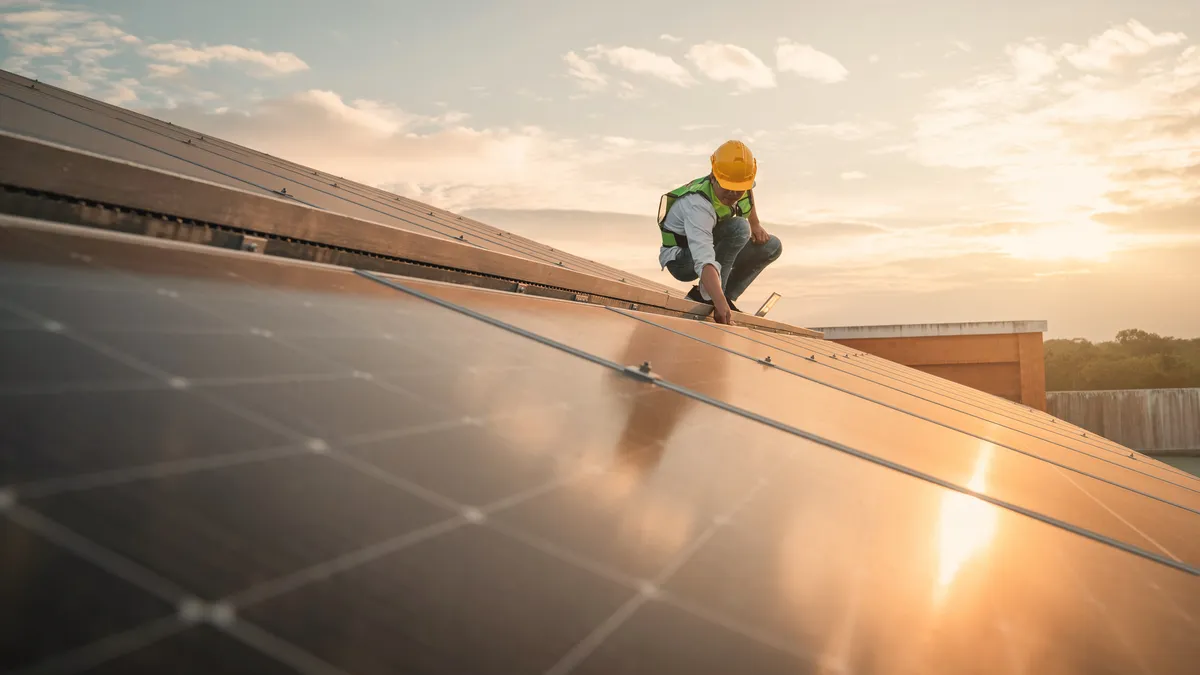Dive Brief:
- The U.S. Department of Energy is awarding $149.9 million to 67 energy conservation and clean energy projects at federal government facilities in the U.S. and abroad, the agency said Oct. 29.
- The awards would be administered through the Assisting Federal Facilities with Energy Conservation Technologies, or AFFECT, grant program. Selected agency projects will leverage nearly $1.6 billion in combined federal funding and private capital to deploy energy conservation and clean energy technologies like solar photovoltaic systems, wind, geothermal, battery energy storage systems, microgrids and building automation systems, DOE said.
- “AFFECT is the key to deploying innovation and underutilized technology across the federal [facility] portfolio,” DOE Federal Energy Management Program Deputy Director Anna Siefken said Oct. 30 at an event unveiling the awards. “With the funding we have now, agencies have the opportunity to continue at the forefront of the clean energy transition.”
Dive Insight:
The awards represent the second and final tranche of $250 million allocated under the bipartisan infrastructure law to the AFFECT program, which aims to help the federal government to achieve President Biden’s net-zero greenhouse gas emissions by 2045 goal.
The second tranche of AFFECT funding is significantly larger than the first, which allocated about $104 million to energy conservation and clean energy projects at 31 federal sites in January. Application volumes doubled from the program’s first phase, with more than $1 billion in funding being requested by agencies this year — more than ever in AFFECT’s 10-year history, according to DOE.
Selected projects will save $41.7 million annually in energy and water costs, generate annual energy savings of over 800,000 metric million British thermal units — equal to 35,701 homes — and eliminate 81,388 metric tonnes of CO2 equivalent each year, DOE said. Awarded projects will also conserve more than 1 billion gallons of water annually and generate 176,383 MWh of clean electricity a year, DOE said.
The projects will benefit facilities operated by the General Services Administration, Department of Defense, Department of Agriculture, Department of Veterans Affairs, Department of Transportation and National Nuclear Security Administration, among other federal agencies. A full list of selected projects and awarded agencies can be found on the project descriptions webpage.
One grant will outfit a U.S. Coast Guard yard in Baltimore with a geothermal heat pump system for building heating and cooling and a new electrical microgrid powered by a biogas combined heat and power plant, solar photovoltaic systems and a battery energy storage system, DOE said.The Coast Guard project will “serve as a model for future installations on how to improve efficiency, implement electrification and utilize multiple renewable energy sources to meet net zero goals,” AFFECT Program Lead Tyler Harris said at the DOE announcement event.
A National Nuclear Security Administration facility in Livermore, California will channel the funding toward expanding the site’s existing solar PV capacity to 9.4 MW, boost its battery energy storage capacity to 2 MWh and add a geothermal heat pump system. The project will generate more than half the facility’s electricity from carbon-free sources, while reducing scope 1 and 2 emissions by 55% from 2008 levels and improving energy resiliency, according to DOE.
The Livermore project will save $20.8 million “over the life of the contract,” Harris said.
The AFFECT grants aim “to spur, even jumpstart, project[s] that may otherwise have sat on the back burner,” while proving out more nascent conservation and clean energy technologies, FEMP Director Mary Sotos said during the Oct. 30 announcement.
Additionally, the second tranche of the AFFECT grants place more emphasis on equity considerations, with about 30% of awarded projects sited in or near disadvantaged communities, Sotos said.
“We know that federal agencies provide services in many of those communities,” Sotos said. “[We are] not just here to buy things for agencies but to create change.”
Interested in more facilities management news? Sign up for Facilities Dive’s newsletter today.














